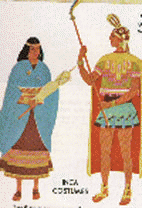


In Cuzco in 1589, Don Mancio Serra de Leguisamo — the last survivor of the original conquerors of Peru — wrote in the preamble of his will not without exaggeration, the following (in parts):
We found these kingdoms in such good order, and the said Incas governed them in such wise [manner] that throughout them there was not a thief, nor a vicious man, nor an adulteress, nor was a bad woman admitted among them, nor were there immoral people. The men had honest and useful occupations. The lands, forests, mines, pastures, houses and all kinds of products were regulated and distributed in such sort that each one knew his property without any other person seizing it or occupying it, nor were there law suits respecting it… the motive which obliges me to make this statement is the discharge of my conscience, as I find myself guilty. For we have destroyed by our evil example, the people who had such a government as was enjoyed by these natives. They were so free from the committal of crimes or excesses, as well men as women, that the Indian who had 100,000 pesos worth of gold or silver in his house, left it open merely placing a small stick against the door, as a sign that its master was out. With that, according to their custom, no one could enter or take anything that was there. When they saw that we put locks and keys on our doors, they supposed that it was from fear of them, that they might not kill us, but not because they believed that anyone would steal the property of another. So that when they found that we had thieves among us, and men who sought to make their daughters commit sin, they despised us.
Politics and government
The Inca Empire was separated into four sections together known as 'Ttahuantin-suyu' or "land of the four sections" each ruled by a governor or viceroy called 'Apu-cuna' under the leadership on the central 'Sapa Inca'. Cuzco was the central capital of the Inca Empire from where the Sapa Inca ruled. According to the oral traditions of the Inca the empire was ruled by 14 kings in succession. The earliest kings are likely either local leaders of ayllus around Cuzco or possibly mythical figures.
The term 'ayllu' refers to a grouping of indigenous people of South America and has been translated as clan. The term represents a group based on assumed blood-ties which operates as an economic and social unit. The Inca Empire was essentially several Andean ayllus controlled by a few Inca ayllus. As an economic unit the ayllu represented collective ownership of the land as well as other resources such as llama herds and water sources. The success and cohesiveness of the Andean ayllus was largely attributed to communal agriculture. Ayllus could regularly split apart because of economic hardships, ignoring blood ties, or come together with other ayllus with whom they did not share genealogy for the purposes necessary co-operation such as in irrigation or defence.
Despite regular conquering or grouping of ayllus, the individual ayllu would remain intact even after a break up of the group or empire to which it had belonged. This was largely because of their economic self-sufficiency. However conquering ayllus like the Inca, by building the collective state, gained economic and political power and developed into the ruling class, but in doing so they lost that self-sufficiency. This meant that the failure or defeat of the collective state meant the demise of the ruling class.
The Inca ayllus were based in Cuzco, the empire's capital, which was divided into Hanan-Cuzco (upper Cuzco) and Hurin-Cuzco (lower Cuzco). This separation, common with Andean ayllus is known as dual divisions. The two halves of the ayllu would from separate customs and rites and would form separate units in the army but would remain on good terms with each other socially, taking part in feasts and mock battles. Dual division was mostly religious and symbolic but had little economic relevance. When a ruler died, their chosen successor would receive all their political power and rights, while the ruler's other male descendants received all the monetary treasures. This process was called split inheritance.
Religion
While the Inca often tolerated or incorporated the religions of their conquered ayllus they also imposed a state religion upon them. The Inca empire was a theocracy in which the Inca king, Sapa Inca, was the descendant of Inti, the sun god. The Inca required tribute, especially before and after battle, to certain gods. Regular and general festivals punctuated the labors of the empire's subjects with food drink and entertainments. Inti Raymi, the festival of the sun god, lasted nine nights, during which Sapa Inca would provide Aqhachicha, a maize beer, to first Inti, then himself, then the nobles, and finally to all people who attended.
Education
The Inca used quipu (bundled knotted strings), for accounting and census purposes. Much of the information on the surviving quipus has been shown to be numeric data; some numbers seem to have been used as mnemonic labels, and the color, spacing, and structure of the quipu carried information as well. How to interpret the coded or non-numeric data remains unknown. However, some scholars still harbor hope that quipus recorded spoken language like a writing system.
Despite accounts kept on quipus, the Inca depended on oral transmission to maintain and preserve their culture. Inca education was divided into two distinct categories: vocational education for common Inca, and formalized training for the nobility.

No comments:
Post a Comment